A record of outings 2014
by Hugh Deam
Buckinghamshire
Saturday 4th October 2014
Stoke Mandeville
SMV (8) 8cwt
Haddenham
SMV (8) 19cwt
The King's Head
Haddenham
Dinton
St Peter & St Paul (6) 17cwt
Heather Banyard, Anita Clayton, Hugh Deam, Simon Edwards, Neil Ephgrave, Charlotte Furneaux, Tim Hillsdon, Simon King, Susan King, Judy Kirby, Paul Lucas, Caroline Luxford, Claire Malone-Lee, Alison Merryweather-Clarke, Donna Murphy, David Parkes, Michael Probert, Colin Taylor and Richard Bennett.
Little Bob Major, Stedman Triples, Middlesex Triples, Plain Bob Triples and Grandsire Triples.
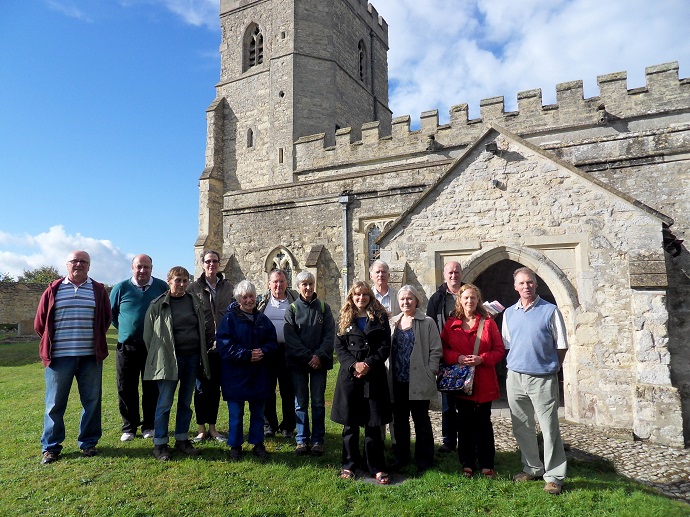
Dinton · St Peter & St Paul
Stoke Mandeville Noted in the Domesday Survey of 1086 as Stoches (a secondary settlement), the manorial affix is from the Mandeville family who held the manor from the 13th century.
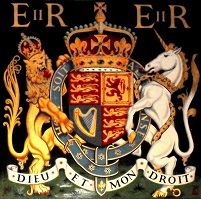 Stoke Mandeville Hospital, Europe's largest spinal injuries unit, is actually situated within Aylesbury. Originally built on open land away from residential housing in the wake of a cholera epidemic so as to lessen the spread of disease, the hospital initially specialised in treating infectious diseases. The Second World War saw the hospital used for treating casualties of the conflict and hence the specialism changed, with the hospital hosting the Stoke Mandeville Games in 1948. This template for the Paralympics was the brainchild of neurologist Sir Ludwig Guttmann. The mascot for the 2012 London Paralympics was named Mandeville in recognition of the inceptive role of the hospital. The original medieval parish church was located on the outskirts of the village, and having steadily fallen into disrepair from late in the 19th century it was finally demolished in 1966.
Stoke Mandeville Hospital, Europe's largest spinal injuries unit, is actually situated within Aylesbury. Originally built on open land away from residential housing in the wake of a cholera epidemic so as to lessen the spread of disease, the hospital initially specialised in treating infectious diseases. The Second World War saw the hospital used for treating casualties of the conflict and hence the specialism changed, with the hospital hosting the Stoke Mandeville Games in 1948. This template for the Paralympics was the brainchild of neurologist Sir Ludwig Guttmann. The mascot for the 2012 London Paralympics was named Mandeville in recognition of the inceptive role of the hospital. The original medieval parish church was located on the outskirts of the village, and having steadily fallen into disrepair from late in the 19th century it was finally demolished in 1966.
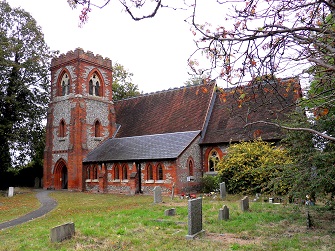
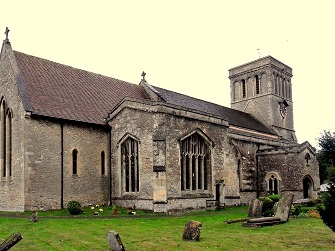 The primarily brick-constructed replacement is from the latter half of the 19th century and stands instead at the central junction of the village. The building work was conducted by J. Medland Taylor of Manchester, which by common consent is thought to have been as a result of the vicar here at the time having hailed from Manchester and knowing the builder from his time there. A monument within the church depicting the children of the Brudenell family (circa 1600) was transferred here from the original church. The bells are a light eight, all cast during the 20th century, with the front two demanding particular care and attention.
The primarily brick-constructed replacement is from the latter half of the 19th century and stands instead at the central junction of the village. The building work was conducted by J. Medland Taylor of Manchester, which by common consent is thought to have been as a result of the vicar here at the time having hailed from Manchester and knowing the builder from his time there. A monument within the church depicting the children of the Brudenell family (circa 1600) was transferred here from the original church. The bells are a light eight, all cast during the 20th century, with the front two demanding particular care and attention.
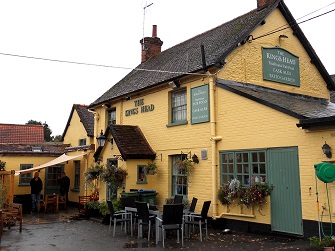
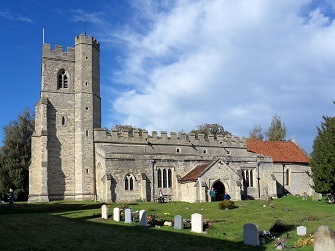 Five of the bells (treble, two, three, five and tenor) were cast between 1928 and 1952 at the Whitechapel foundry, with the other three bells cast earlier in 1910 and 1913 at the Birmingham foundry of James Barwell & Co.
Haddenham See Saturday 28th November 1987 for details of Haddenham village and church.
The King's Head This rightly well-regarded country pub was originally a Tap Room from the 14th century, but at some point during the 17th century the building was badly damaged by a fire inadvertently started by a lay preacher who left a candle burning in a room before going off to the church. The pub is very popular as the menu is extensive and well priced by comparison to most of the pubs in the surrounding area.
Dinton See Saturday 28th November 1987 for details.
Five of the bells (treble, two, three, five and tenor) were cast between 1928 and 1952 at the Whitechapel foundry, with the other three bells cast earlier in 1910 and 1913 at the Birmingham foundry of James Barwell & Co.
Haddenham See Saturday 28th November 1987 for details of Haddenham village and church.
The King's Head This rightly well-regarded country pub was originally a Tap Room from the 14th century, but at some point during the 17th century the building was badly damaged by a fire inadvertently started by a lay preacher who left a candle burning in a room before going off to the church. The pub is very popular as the menu is extensive and well priced by comparison to most of the pubs in the surrounding area.
Dinton See Saturday 28th November 1987 for details.

Stoke Mandeville

Stoke Mandeville · SMV

Haddenham · SMV

The King's Head · Haddenham

Dinton · St Peter & St Paul
Oxfordshire
Sunday 31st August 2014
2.00pm Marsh Gibbon
St Mary the Virgin (5) 13cwt
Hugh Deam, Judy Kirby, Susan & Simon King, Lucy & Anthony Hughes and Paul Lucas.
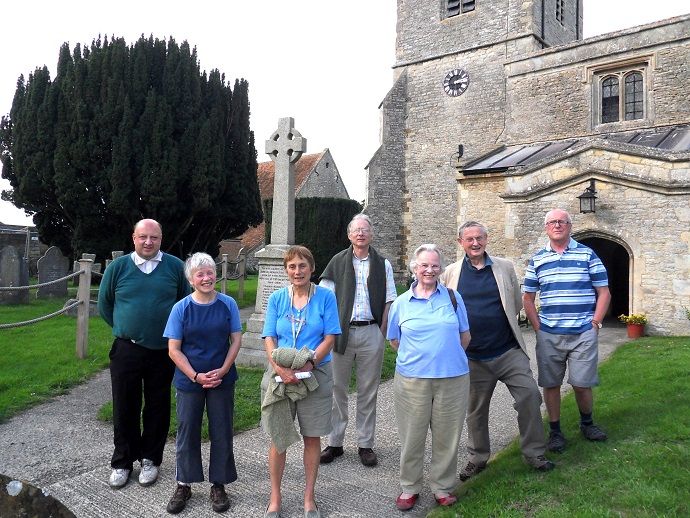
Marsh Gibbon · St Mary the Virgin
Marsh Gibbon Originally known just as Merse (marsh), the settlement gained its manorial affix during 1292 - Mersh Gibuyne - recognising the Gibwen family, here from the 12th century. The village that exists today is the result of several diverse hamlets merging over the centuries, and hence there is a multiplicity of roads wending in and out.
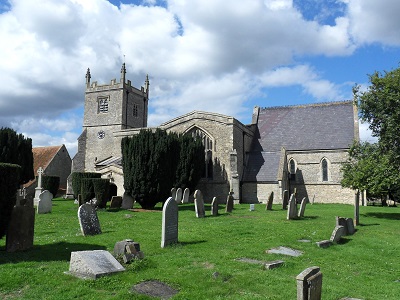 In 1437 the village was granted to an almshouse trust founded at Ewelme. In 1617, James I granted the mastership of the trust to the Regius Professor of Medicine at Oxford University, a position that still pertains. The stone rubble constructed parish church is mostly 13th century and cruciform in design. The imposing tower was rebuilt in 1888, with the church undergoing a general restoration at that time, work which included the addition of the north aisle. Although the tower matches the church building in stature, it surprisingly only houses five bells, the oldest being the 2nd and 4th, both cast in 1678 by Richard III Chandler of Drayton Parslow. The treble is of 1848 by William Taylor at the foundry in Oxford. The fifth is from six years later, cast by John Warner & Sons of London. The third is the most recent, cast in 1970 at Whitechapel. The bells were long rung from the ground floor, but the construction of a gallery has made them a far more attractive proposition to ring.
In 1437 the village was granted to an almshouse trust founded at Ewelme. In 1617, James I granted the mastership of the trust to the Regius Professor of Medicine at Oxford University, a position that still pertains. The stone rubble constructed parish church is mostly 13th century and cruciform in design. The imposing tower was rebuilt in 1888, with the church undergoing a general restoration at that time, work which included the addition of the north aisle. Although the tower matches the church building in stature, it surprisingly only houses five bells, the oldest being the 2nd and 4th, both cast in 1678 by Richard III Chandler of Drayton Parslow. The treble is of 1848 by William Taylor at the foundry in Oxford. The fifth is from six years later, cast by John Warner & Sons of London. The third is the most recent, cast in 1970 at Whitechapel. The bells were long rung from the ground floor, but the construction of a gallery has made them a far more attractive proposition to ring.

St Mary the Virgin
Oxfordshire
Saturday 19th July 2014
10.00am Chipping Norton
St Mary the Virgin (8) 14cwt
Isaac O'Shea, Alena Ptak-Danchak, David Thomas, Donna Murphy, Susan King, Simon King, Judy Kirby, Simon Edwards, John Pusey, Alison Merryweather-Clarke, Hugh Deam, Mike Probert, Toby Goss, Neil Ephgrave & Paul Lucas.
Plain & Little Bob Major, Stedman & Grandsire Triples.
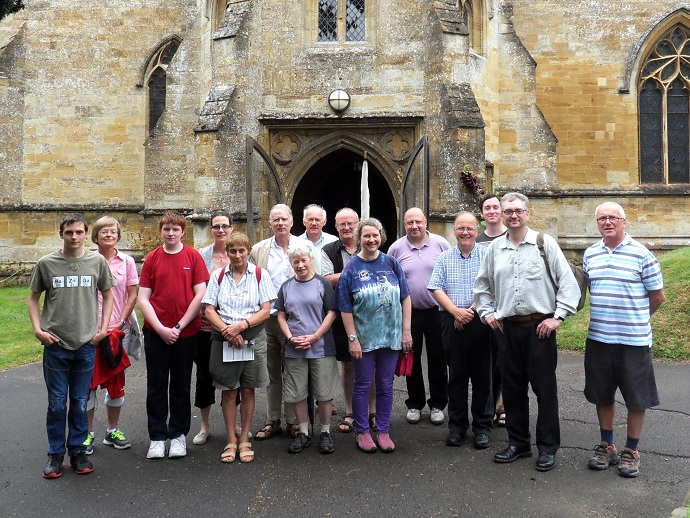
Chipping Norton · St Mary the Virgin
Chipping Norton Originally documented as Nortone (a northern farmstead) in 1086, the distinguishing affix coming from 1224 and the evolvement of the wool trade, the name Chepingnorthona denoting this as a market town. At 700ft above sea level, Chipping Norton is the highest town in Oxfordshire, and is usually the coldest town in the county during the winter months. The area has been populated since pre-historic times, with the complex of Neolithic and Bronze Age monuments known as the Rollright Stones located just to the north of the town.
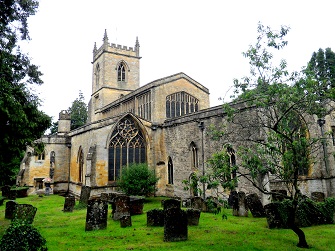
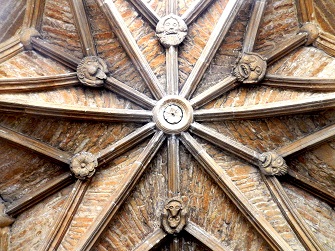 The chimney of Bliss Mill has dominated the skyline of the town since 1872, the tweed mill having been built for industrialist William Bliss. Although the chimney still stands proud, the mill was converted into residential apartments in 1980. A street market is held in the town on the third Saturday of the month, our visit coinciding with such a Saturday. In recent years the name of the town has, for good or ill, become synonymous with "the Chipping Norton Set", these being amongst the movers and shakers in politics and the media (David Cameron, Jeremy Clarkson, Rebekah Brooks).
The chimney of Bliss Mill has dominated the skyline of the town since 1872, the tweed mill having been built for industrialist William Bliss. Although the chimney still stands proud, the mill was converted into residential apartments in 1980. A street market is held in the town on the third Saturday of the month, our visit coinciding with such a Saturday. In recent years the name of the town has, for good or ill, become synonymous with "the Chipping Norton Set", these being amongst the movers and shakers in politics and the media (David Cameron, Jeremy Clarkson, Rebekah Brooks).
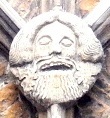
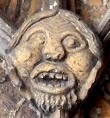
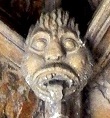
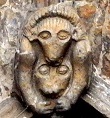
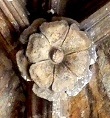
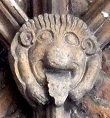 The prevailing aspect of the church is from the late 15th century, when the nave was rebuilt, although fragments remain in the stonework from the previous three centuries. In keeping with many Cotswold towns, the endowment of rich detail within the church is primarily as a result of the wool trade. The broad west tower was rebuilt in 1825, and houses a ring of eight bells, all of which were cast in 1907 at Whitechapel. The Sanctus bell survives from 1624, having been cast by Roger Purdue at the foundry in Bristol. The bells require confident handling in order to achieve the desired results.
The prevailing aspect of the church is from the late 15th century, when the nave was rebuilt, although fragments remain in the stonework from the previous three centuries. In keeping with many Cotswold towns, the endowment of rich detail within the church is primarily as a result of the wool trade. The broad west tower was rebuilt in 1825, and houses a ring of eight bells, all of which were cast in 1907 at Whitechapel. The Sanctus bell survives from 1624, having been cast by Roger Purdue at the foundry in Bristol. The bells require confident handling in order to achieve the desired results.

St Mary the Virgin

The vaulted porch ceiling






Chipping Norton · The grotesques in detail · St Mary the Virgin
Oxfordshire
Sunday 29th June 2014
2.30pm Swalcliffe
St Peter & St Paul (6) 13cwt
Lindsay Powell, Chris Powell, Charles Smith, Donna Murphy, Judy Kirby,
Jesus Anonuevo, David Parkes, Hugh Deam and Paul Lucas.
Plain Bob Minor & Grandsire Doubles.
Jesus Anonuevo, David Parkes, Hugh Deam and Paul Lucas.
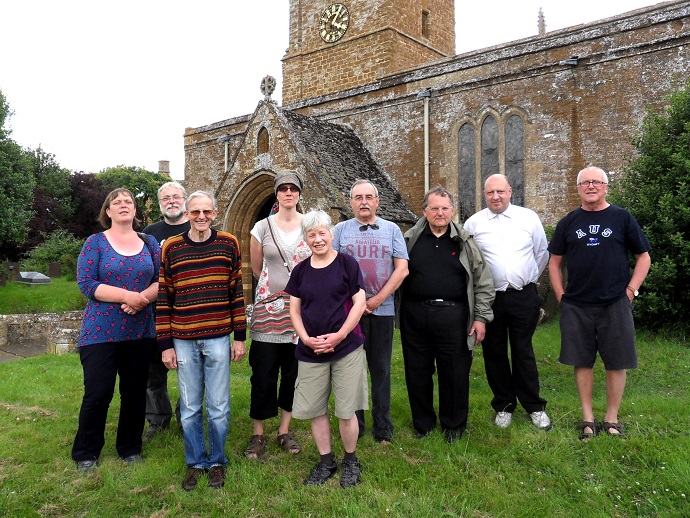
Swalcliffe · St Peter & St Paul
Swalcliffe Located on the course of what was a Roman road, now a bridleway, the name of the village derives from the Anglo-Saxon description of a cliff or slope frequented by swallows. Just north of Swalcliffe, on Madmarston Hill there is the site of an Iron Age hill-fort, and also the site of what was once a Roman villa. The famous tithe barn here was built for New College, Oxford, between 1401 and 1407, being owned now by the Oxfordshire Buildings Trust.
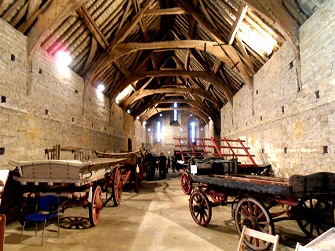
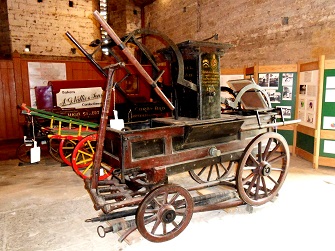
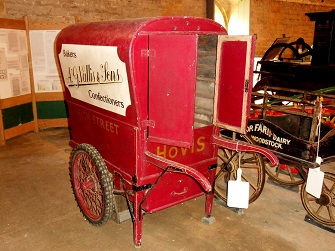
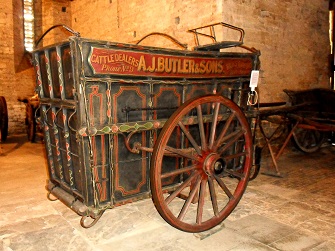 It has an almost entirely intact medieval timber roof, and is considered one of the finest existing examples of its type in the country. The barn is open on Sundays from Easter to October, and houses part of the Oxfordshire Museum’s collection of early agricultural and trade vehicles. The parish church is 11th century in origin, with the chancel of the Saxon building incorporated in north and south arcades of the present nave. There was an extensive restoration conducted by Richard Charles Hussey between 1854 and 1856, with the interior containing numerous large marble and stone monuments from the 16th and 17th centuries.
It has an almost entirely intact medieval timber roof, and is considered one of the finest existing examples of its type in the country. The barn is open on Sundays from Easter to October, and houses part of the Oxfordshire Museum’s collection of early agricultural and trade vehicles. The parish church is 11th century in origin, with the chancel of the Saxon building incorporated in north and south arcades of the present nave. There was an extensive restoration conducted by Richard Charles Hussey between 1854 and 1856, with the interior containing numerous large marble and stone monuments from the 16th and 17th centuries.
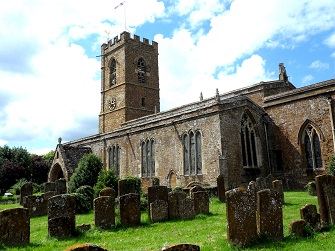
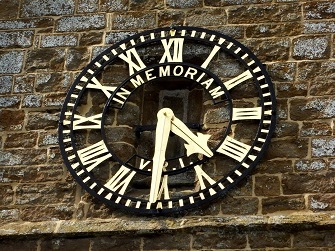 The lower part of the west tower is 13th century, with the upper stage from the 15th century. Thirty spiral steps lead up to the ringing chamber, with the bells being a splendid weighty six well worth visiting for a ring. With the exception of the third, the bells are the work of Henry & Matthew Bagley, Chacombe, 1685. The third was recast by Richard Sanders of Bromsgrove in 1720. After ringing prior to the yearly pet service we were able to relax and concentrate on picnicking in a corner of the large churchyard on what was a glorious summer afternoon.
The lower part of the west tower is 13th century, with the upper stage from the 15th century. Thirty spiral steps lead up to the ringing chamber, with the bells being a splendid weighty six well worth visiting for a ring. With the exception of the third, the bells are the work of Henry & Matthew Bagley, Chacombe, 1685. The third was recast by Richard Sanders of Bromsgrove in 1720. After ringing prior to the yearly pet service we were able to relax and concentrate on picnicking in a corner of the large churchyard on what was a glorious summer afternoon.

The tithe barn

A fire engine dated 1760

A.G. Vallis & Sons
Bakers · Confectioners · High Street
Bakers · Confectioners · High Street

A.J. Butler & Sons
Cattle Dealers · High St · Burford
Cattle Dealers · High St · Burford

St Peter & St Paul

The face of the church clock
Oxfordshire
Saturday 14th June 2014
10.30am Combe
St Laurence (6) 12cwt
Paul Lucas, Charles Smith, Colin Taylor, Toby Goss, Bernard Masterman,
Andrew Freer, Anthony Williamson, Judy Kirby, Hugh Deam and Andrew Kenyon.
Cambridge, Plain Bob Minor & Stedman.
Andrew Freer, Anthony Williamson, Judy Kirby, Hugh Deam and Andrew Kenyon.
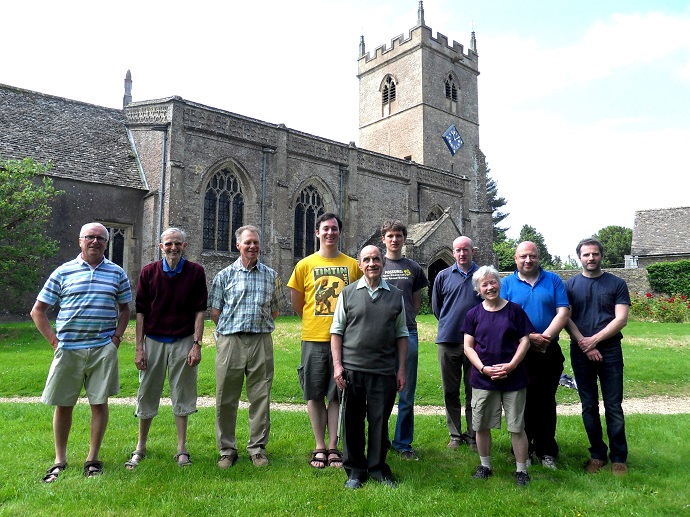
Combe · St Laurence
Combe From the Anglo-Saxon description of a valley, the name Combe is most common in the West Country. Bordering the north western flank of the Blenheim Estate, the village is somewhat dispersed, hence the ecclesiastical parish name of Combe Longa. The estate’s former sawmill, Combe Mill, is now a working museum, with alternative power sources. A steam powered rotative beam-engine was added in 1852 to work alongside the existing water-wheel powered by the River Evenlode. The pub here – The Cock Inn – was built late in the 17th century and overlooks the village green, which is the setting for four of Combe’s yearly festivals. The festival year begins with a children’s maypole dance, followed by a summer ball, a funfair in early autumn and concluding with a firework display on Guy Fawkes Night. Indeed on the day of our visit we were able to take advantage of there being a coffee morning at the village hall overlooking the green, languidly sampling the cakes and drinking tea or coffee in the garden, with the accompaniment of Native American powwow drumming performed by local youngsters nearby.
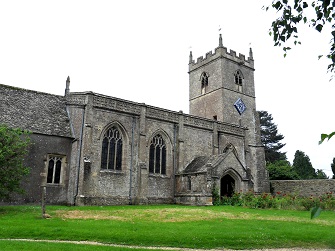
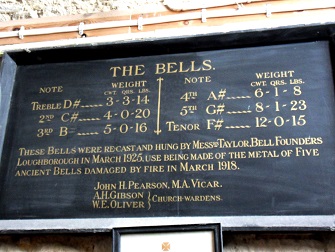 The stroll on Church Walk towards St Laurence’s church passes the old village pump, with much of the churchyard bordering a cricket ground. The Grade 1 Listed parish church was built in 1395 for Eynsham Abbey, with its interior containing several 15th century wall paintings, including a Doom over the chancel arch. In 1918 a fire damaged the tower, the bells and the clock. The remains of the clock were salvaged, restored and then installed in the History of Science Museum in Oxford. John Taylor & Co of Loughborough recast the bells as a ring of six in March 1925 from the metal of the original five bells of the 17th century which were damaged by the fire in the same month seven years before. The bells are rung from the ground floor and are an excellent set.
The stroll on Church Walk towards St Laurence’s church passes the old village pump, with much of the churchyard bordering a cricket ground. The Grade 1 Listed parish church was built in 1395 for Eynsham Abbey, with its interior containing several 15th century wall paintings, including a Doom over the chancel arch. In 1918 a fire damaged the tower, the bells and the clock. The remains of the clock were salvaged, restored and then installed in the History of Science Museum in Oxford. John Taylor & Co of Loughborough recast the bells as a ring of six in March 1925 from the metal of the original five bells of the 17th century which were damaged by the fire in the same month seven years before. The bells are rung from the ground floor and are an excellent set.

Combe

St Laurence
The Chilterns
Saturday 31st May 2014
10.30am Lane End
Holy Trinity (6) 5cwt
12.00pm Turville
St Mary (5) 7cwt
01.30pm The Bull & Butcher
Turville
Janice Beale, John Beale, Jonathan Beale, Hugh Deam, Charlotte Furneaux, Toby Goss, Judy Kirby, Paul Lucas, Donna Murphy, David Parks, Charlotte Ritchie and Colin Taylor.
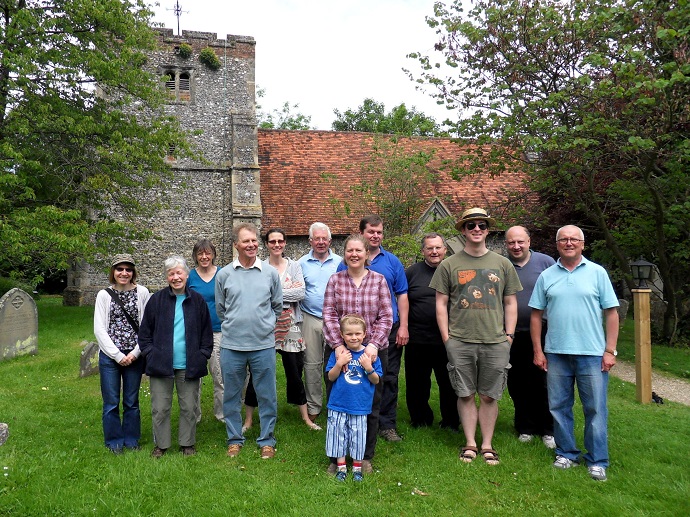
Turville · St Mary
The Bull & Butcher The caustic name of this rustic and historic 16th century pub derives from the fatalistic and tumultuous marriage of Henry VIII and Anne Boleyn. Prior to her time at the French court, Anne’s surname was spelled Bullen, and the butcher of the piece is self-explanatory. The pub, with its warm low-beamed interior, has long been a keenly regarded meeting up place for locals and visitors from far afield alike. Our previous outing to the village in late April 2001 came in the wake of the Foot & Mouth Disease outbreak that blighted the country early that year.
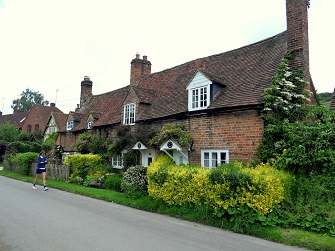
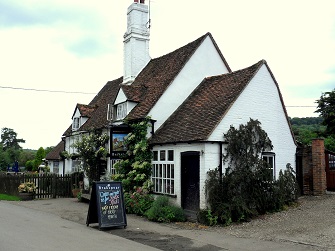 Buckinghamshire County Council imposed some of the most draconian restrictions on countryside movements and consequently Turville was one of the worst affected villages, with the loss of trade from walkers, cyclists, pony-trekkers as well as visiting bell-ringers. Even after the lifting of exclusion zones it was not an overnight return to how things had been, but fortunately the pub survived this and has gained an even wider recognition having made several high-profile appearances in ITV’s long running Midsomer Murders since.
Lane End See Sat 28th October 1989.
Turville See Sat 28th May 2001 for a description of the village.
Buckinghamshire County Council imposed some of the most draconian restrictions on countryside movements and consequently Turville was one of the worst affected villages, with the loss of trade from walkers, cyclists, pony-trekkers as well as visiting bell-ringers. Even after the lifting of exclusion zones it was not an overnight return to how things had been, but fortunately the pub survived this and has gained an even wider recognition having made several high-profile appearances in ITV’s long running Midsomer Murders since.
Lane End See Sat 28th October 1989.
Turville See Sat 28th May 2001 for a description of the village.

Turville

The Bull & Butcher
Wiltshire
Saturday 17th May 2014
10.30am Latton
St John the Baptist (5) 9cwt
11.45am Broad Blunsdon
St Leonard (8) 5cwt
01.00pm Lunch The Heart in Hand
Broad Blunsdon
Mary Carroll, Hugh Deam, Hayley Fisher, Toby Goss, Simon King, Susan King,
Judy Kirby, Claire Malone-Lee, Bernard Masterman, Jesus Nuevo and David Parkes.
Judy Kirby, Claire Malone-Lee, Bernard Masterman, Jesus Nuevo and David Parkes.
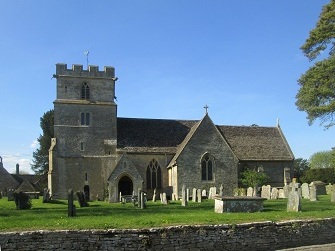
Latton · St John
Latton Noted in 1086 as Latone, the name references a leek or garlic enclosure that existed here. The Thames & Severn Canal long ran adjacent to the village on its way to the junction with the North Wilts Canal. In keeping with the steady revival of the canal network, restoration work has been taking place over recent years. One of the country’s leading alpaca farms is located here, with dozens of adults and crias (baby alpacas) on show. The Grade 1 Listed church is constructed of local limestone and dates to the 12th century, the manor of Latton having been gifted to Cirencester Abbey by Henry I in 1133. The chancel was rebuilt twice during the 19th century, the second course of work being overseen by William Butterfield, with the church roof comprised of Cotswold stone tiles. The broad tower is Norman in its lower part and Perpendicular in its upper part, surmounted by battlements. The tower houses five bells which are hung counter-clockwise, with treble and back three all cast by Abel Rudhall at the Gloucester foundry in in 1709.
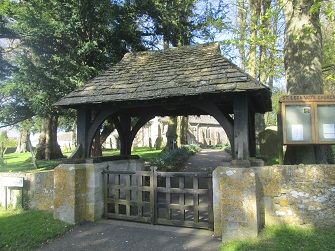 The second bell was cast by Thomas II Mears at the Whitechapel foundry in 1841. The bells are rarely rung and pose a variety of challenges in handling.
Broad Blunsdon Described in the Domesday Book as Bluntesdone (Blunt’s hill), this now extensive village is situated adjacent to the A419 Cirencester to Swindon road, with Blunsdon St Andrew on the western side of the dual carriageway. The parish church, constructed from local limestone, is set in a peaceful glade, with a host of mature trees surrounding the churchyard. Until 1867 the church here was administered by a curate from Highworth. In that year Samuel Forbes Auchmuty was appointed the first rector here and he swiftly initiated the restoration of the building by famed Gothic Revival architect William Butterfield in 1870, although south arcade survives from the 13th century. The Perpendicular west tower contains eight bells, the back six bells dating to 1913, cast by John Warner & Sons, London. The front two bells were cast by Whitechapel in 2002. Besides providing us with an extremely useful session of ringing there was the added bonus of a book sale and refreshments available within the church. On such a sunny day we were able to enjoy an excellent lunch in the garden of the village pub - The Heart in Hand.
The second bell was cast by Thomas II Mears at the Whitechapel foundry in 1841. The bells are rarely rung and pose a variety of challenges in handling.
Broad Blunsdon Described in the Domesday Book as Bluntesdone (Blunt’s hill), this now extensive village is situated adjacent to the A419 Cirencester to Swindon road, with Blunsdon St Andrew on the western side of the dual carriageway. The parish church, constructed from local limestone, is set in a peaceful glade, with a host of mature trees surrounding the churchyard. Until 1867 the church here was administered by a curate from Highworth. In that year Samuel Forbes Auchmuty was appointed the first rector here and he swiftly initiated the restoration of the building by famed Gothic Revival architect William Butterfield in 1870, although south arcade survives from the 13th century. The Perpendicular west tower contains eight bells, the back six bells dating to 1913, cast by John Warner & Sons, London. The front two bells were cast by Whitechapel in 2002. Besides providing us with an extremely useful session of ringing there was the added bonus of a book sale and refreshments available within the church. On such a sunny day we were able to enjoy an excellent lunch in the garden of the village pub - The Heart in Hand.

Broad Blunsdon · St Leonard
Buckinghamshire
Saturday 26th April 2014
Stowe
Assumption BVM (6) 10cwt
Lillingstone Lovell
ABVM (6) 6½cwt
The Wheatsheaf
Maids Moreton
Brian Curtis, Lorna Curtis, Hugh Deam, Neil Ephgrave, Roy Jones, Simon King, Susan King, Judy Kirby, Paul Lucas, Alison Merryweather-Clarke, Donna Murphy, David Parkes and Mike Probert.
Cambridge, Single Oxford, St Lawrence Little Bob, St Clements, Little Bob, Plain Bob Minor & Stedman.
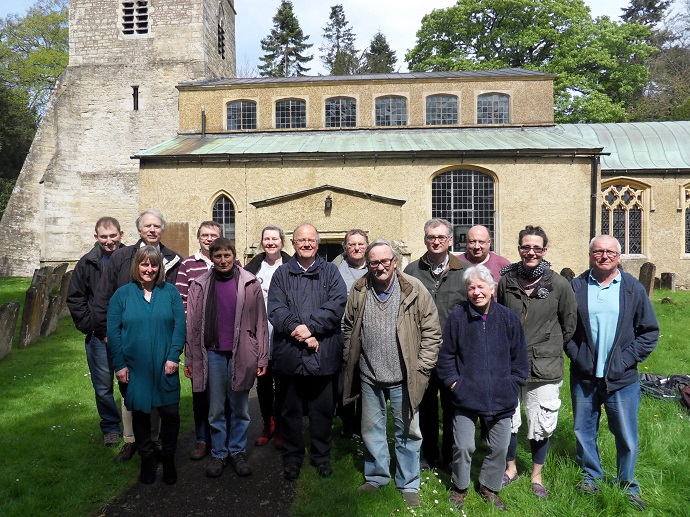
The ringers at Stowe
Stowe The name of the village references an assembly place, usually holy in nature. The first feudal overlord of the manor here was William the Conqueror’s half-brother, Odo, Bishop of Bayeux, with a college of secular canons being founded here by Roger d’Ivry and Robert D’Oyly, who also founded Oxford Castle. By 1150, the Augustinian Osney Abbey had taken responsibility for the college, and retained Stowe up until the Dissolution. In 1590, Queen Elizabeth I granted Stowe, including its deer park, to secular owners.
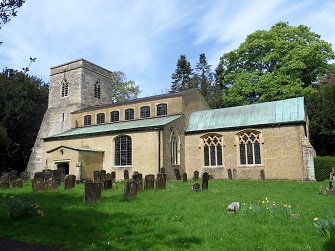
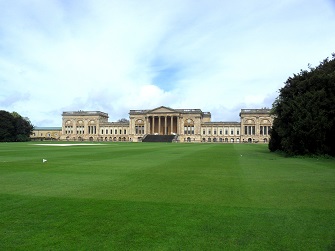 Stowe House is a late 18th century Grade 1 Listed mansion that was the country seat of the Dukes of Buckingham and Chandos, but which has been occupied by Stowe School since 1923. During the 18th and 19th century, many European monarchs and leading writers and philosophers of the day visited Stowe House. The magnificent landscaped gardens and its many monuments were acquired by the National Trust in 1990, and since that time a programme of restoration of the grounds, temples and follies has been undertaken.
Stowe House is a late 18th century Grade 1 Listed mansion that was the country seat of the Dukes of Buckingham and Chandos, but which has been occupied by Stowe School since 1923. During the 18th and 19th century, many European monarchs and leading writers and philosophers of the day visited Stowe House. The magnificent landscaped gardens and its many monuments were acquired by the National Trust in 1990, and since that time a programme of restoration of the grounds, temples and follies has been undertaken.
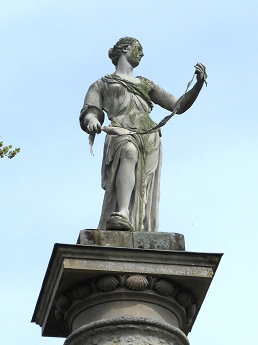 The landscaping of the gardens here was Capability Brown’s first commission, and he was also married here. The house and gardens have appeared as a location for high-profile films such as Indiana Jones and the Last Crusade, The World Is Not Enough and also Bollywood movies. Although they may not realise the connection, the name of the village is indelibly known to millions of avid Formula One motor racing fans worldwide for the famous corner named after it on the Silverstone circuit nearby. The earliest part of the parish church is the 13th century three-bay arcade between the nave and the north aisle. The chancel and south aisle were added in the following century, with the aisles rebuilt in the 15th century. The 13th century west tower houses six bells, the back five of which were all cast by the Keene family at their foundry in Woodstock, between 1654 and 1665. The current treble was added in 1988 by Taylors of Loughborough. The third bell is exceptionally odd struck and is an interesting challenge.
Lillingstone Lovell The Domesday Book notes the settlement here as Lillingestan (boundary stone of the followers of a man called Lytel), reflecting the proximity of the border with what is now Northamptonshire. The manorial affix from about a century later references the early possession by the Lovell family with the smaller twin village of Lillingstone Dayrell being just to the south. The church and Georgian period rectory are set together on the south side of the village. The narrow nave of the church was lengthened when the church was rebuilt in the 14th century. Notable features of the interior are the richly endowed pulpit and superb 18th century box-pews. The early 13th century tower was left untouched by the rebuilding of the church in the following century, but has a steep saddleback roof of a later date that nonetheless blends well with the pre-existing materials and fabric.
The landscaping of the gardens here was Capability Brown’s first commission, and he was also married here. The house and gardens have appeared as a location for high-profile films such as Indiana Jones and the Last Crusade, The World Is Not Enough and also Bollywood movies. Although they may not realise the connection, the name of the village is indelibly known to millions of avid Formula One motor racing fans worldwide for the famous corner named after it on the Silverstone circuit nearby. The earliest part of the parish church is the 13th century three-bay arcade between the nave and the north aisle. The chancel and south aisle were added in the following century, with the aisles rebuilt in the 15th century. The 13th century west tower houses six bells, the back five of which were all cast by the Keene family at their foundry in Woodstock, between 1654 and 1665. The current treble was added in 1988 by Taylors of Loughborough. The third bell is exceptionally odd struck and is an interesting challenge.
Lillingstone Lovell The Domesday Book notes the settlement here as Lillingestan (boundary stone of the followers of a man called Lytel), reflecting the proximity of the border with what is now Northamptonshire. The manorial affix from about a century later references the early possession by the Lovell family with the smaller twin village of Lillingstone Dayrell being just to the south. The church and Georgian period rectory are set together on the south side of the village. The narrow nave of the church was lengthened when the church was rebuilt in the 14th century. Notable features of the interior are the richly endowed pulpit and superb 18th century box-pews. The early 13th century tower was left untouched by the rebuilding of the church in the following century, but has a steep saddleback roof of a later date that nonetheless blends well with the pre-existing materials and fabric.
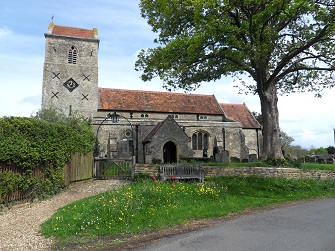
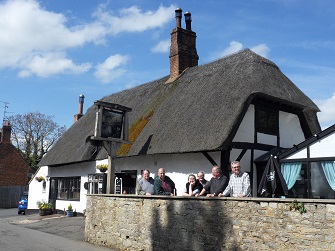 The back four bells date to 1693, cast by Alexander Rigby of Stamford. The set was increased to five in 1952 with the installation of a bell cast by Taylors of Loughborough. On Friday 24th June 2011, the newly installed treble, making this a ring of six, was rung for the first time. The inscription on the bell is: Whitechapel made me and the residents of Lovell gave me. Unusually, the bells ring in the minor key. There are no longer any pubs in the Lillingstone villages but we enjoyed a splendid lunch at The Wheatsheaf in nearby Maids Moreton.
The back four bells date to 1693, cast by Alexander Rigby of Stamford. The set was increased to five in 1952 with the installation of a bell cast by Taylors of Loughborough. On Friday 24th June 2011, the newly installed treble, making this a ring of six, was rung for the first time. The inscription on the bell is: Whitechapel made me and the residents of Lovell gave me. Unusually, the bells ring in the minor key. There are no longer any pubs in the Lillingstone villages but we enjoyed a splendid lunch at The Wheatsheaf in nearby Maids Moreton.

Stowe · ABVM

Stowe House

Capt Grenville's Column

Lillingstone Lovell · ABVM

The Wheatsheaf
Wiltshire
Saturday 22nd March 2014
10.00am Royal Wootton Bassett
St Bartholomew & All Saints (8) 19cwt
11.00am Lyneham
St Michael (6) 14cwt
12.15pm Lydiard Tregoze
St Mary (6) 11cwt
01.15pm Lunch The Sun Inn
Lydiard Millicent
02.30pm Lydiard Millicent
All Saints (6) 10cwt
03.30pm Purton
St Mary (8) 20cwt
Erica Ashton, Rupert Boulting, Jane Burgess, Ron Burgess, Mary Carroll, Margaret Craig, Hugh Deam, Neil Ephgrave, Andrew Freer, Charlotte Furneaux, Toby Goss, Anne Gingell, Tim Hillsden, Anthony Hughes, Roy Jones, Simon King, Susan King, Judy Kirby, Paul Lucas, Donna Murphy, Jesus Nuevo, David Parks, Lindsay Powell, Mike Probert, Charles Smith, Colin Taylor, Peter Trowles, Victoria Wylye-Echevaria and Kathy Xu.
Stedman, Grandsire, Cambridge, Double Oxford, Double Bob, St Clements & Plain Bob.
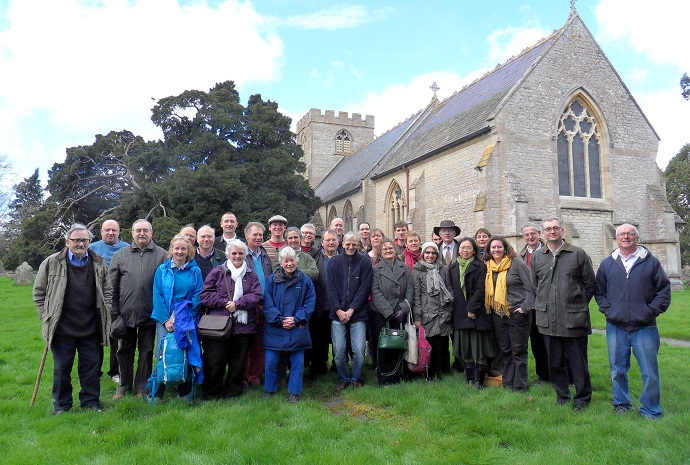
Before Lyneham St Michael
Royal Wootton Bassett A settlement was first documented as being here in 680AD when it was known as Wdetun (farmstead near a wood). In the wake of being sacked by marauding Danes early in the 11th century, the main focus of building moved to higher and more defendable ground. The manorial affix from 1272 denotes the Bassett family, here during that century. The 8,000 sq. metre Wootton Bassett Mud Spring consists of five main sites of oozing springs of cold grey mud which blister up under a thin layer of vegetation. Some of these springs are over 120 metres deep. The magnificent half-timbered town hall of 1700 is now used as a museum, housing an extensive collection of photographs detailing the development of the town, plus geological items, a ducking stool, stocks and a whipping post.
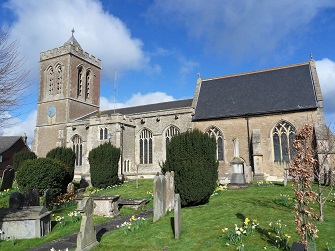
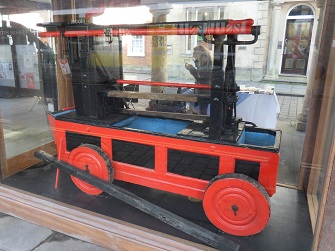 The upper storey is supported on 15 pillars and was extensively restored in 1889. Underneath the museum is the village fire pump which dates to 1725. In the early 21st century the town became nationally known for the informal tributes it paid during military repatriation funeral processions en route from RAF Lyneham to the John Radcliffe Hospital in Oxford, with the closure of RAF Lyneham in 2011, the repatriations moved to Brize Norton and Carterton became the focus of such tributes. One month after this transfer the addition of the title “Royal” was enacted through letters patent, becoming effective on 16 October 2011, when the Princess Royal visited the town. The town is only the third such Royal town in the country, after Leamington Spa and Tunbridge Wells. As we arrived early there was time for our party to see some of the town, with a Saturday market taking place in the High Street. The parish church is primarily Victorian, designed by George Edmund Street, and incorporating remnants of its 13th and 15th century predecessors. The tower retains three bells (now the fourth, seventh and tenor) from 1633, cast by Roger Purdue of Bristol. The other five bells are all from 1890, cast by John Warner & Sons, London. The bells are a fine eight that trip round nicely.
The upper storey is supported on 15 pillars and was extensively restored in 1889. Underneath the museum is the village fire pump which dates to 1725. In the early 21st century the town became nationally known for the informal tributes it paid during military repatriation funeral processions en route from RAF Lyneham to the John Radcliffe Hospital in Oxford, with the closure of RAF Lyneham in 2011, the repatriations moved to Brize Norton and Carterton became the focus of such tributes. One month after this transfer the addition of the title “Royal” was enacted through letters patent, becoming effective on 16 October 2011, when the Princess Royal visited the town. The town is only the third such Royal town in the country, after Leamington Spa and Tunbridge Wells. As we arrived early there was time for our party to see some of the town, with a Saturday market taking place in the High Street. The parish church is primarily Victorian, designed by George Edmund Street, and incorporating remnants of its 13th and 15th century predecessors. The tower retains three bells (now the fourth, seventh and tenor) from 1633, cast by Roger Purdue of Bristol. The other five bells are all from 1890, cast by John Warner & Sons, London. The bells are a fine eight that trip round nicely.
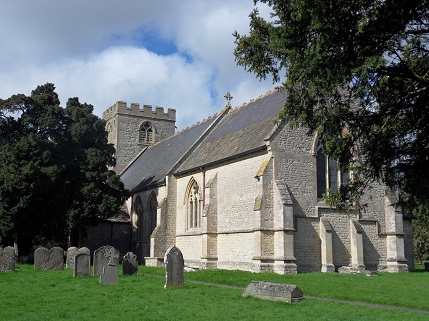
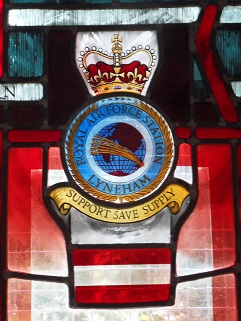 Lyneham Taking its name from a homestead where flax is grown, the settlement was noted as Linham in 1224. Bradenstoke Priory was founded here in the 12th century by Walter FitzEdward, but all that remains now is its tower and under-croft. Much of the lodging, banqueting hall and tithe barn were dismantled, crated and shipped to California in the 20th century. During the second half of the 20th century Lyneham became synonymous with the air force station which was built in 1939 on land previously occupied by the manor house. The RAF’s C-130 Hercules fleet was based here until June 2011. Now MOD Lyneham is being re-developed into a technical training college. The parish church dates from the 14th and 15th centuries, and consists of a chancel, nave, north aisle, south porch and embattled west tower. A new chancel was built in 1860, work overseen by William Butterfield. The tower contains six bells, the three oldest of which were cast by unknown founders. The fourth bell is from 1685, cast by Richard Keene of Woodstock. The tenor is from 1879, by Llewellins & James, Bristol, and the third is from 1925 by Mears & Stainbank. The bells are a fine six, but unfortunately the ropes were inordinately long at this time as they were awaiting shortening, a mistake having been made in ordering the length of rope recently.
Lyneham Taking its name from a homestead where flax is grown, the settlement was noted as Linham in 1224. Bradenstoke Priory was founded here in the 12th century by Walter FitzEdward, but all that remains now is its tower and under-croft. Much of the lodging, banqueting hall and tithe barn were dismantled, crated and shipped to California in the 20th century. During the second half of the 20th century Lyneham became synonymous with the air force station which was built in 1939 on land previously occupied by the manor house. The RAF’s C-130 Hercules fleet was based here until June 2011. Now MOD Lyneham is being re-developed into a technical training college. The parish church dates from the 14th and 15th centuries, and consists of a chancel, nave, north aisle, south porch and embattled west tower. A new chancel was built in 1860, work overseen by William Butterfield. The tower contains six bells, the three oldest of which were cast by unknown founders. The fourth bell is from 1685, cast by Richard Keene of Woodstock. The tenor is from 1879, by Llewellins & James, Bristol, and the third is from 1925 by Mears & Stainbank. The bells are a fine six, but unfortunately the ropes were inordinately long at this time as they were awaiting shortening, a mistake having been made in ordering the length of rope recently.
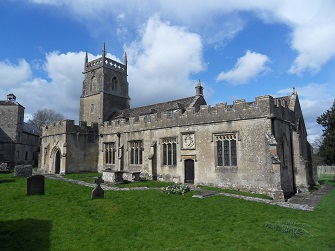
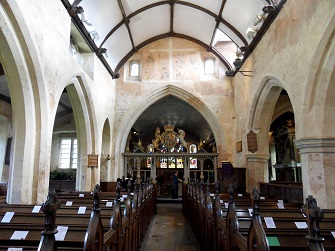 Lydiard Tregoze The twin Lydiard villages derive their name from a grey coloured ridge, being documented as Lidgeard in 1086. The first notation of the manorial affix is from 1196, denoting the Tresgoz family. The village was originally centred on the church and manor house, but gradually disappeared as the grounds of the country house were expanded and landscaped. Lydiard House was, for some 500 years, the home of the St John family, who carried influence at court during the Tudor dynasty, Margaret Beaufort, mother of Henry VII, being the step-daughter of Oliver St John.
Lydiard Tregoze The twin Lydiard villages derive their name from a grey coloured ridge, being documented as Lidgeard in 1086. The first notation of the manorial affix is from 1196, denoting the Tresgoz family. The village was originally centred on the church and manor house, but gradually disappeared as the grounds of the country house were expanded and landscaped. Lydiard House was, for some 500 years, the home of the St John family, who carried influence at court during the Tudor dynasty, Margaret Beaufort, mother of Henry VII, being the step-daughter of Oliver St John.
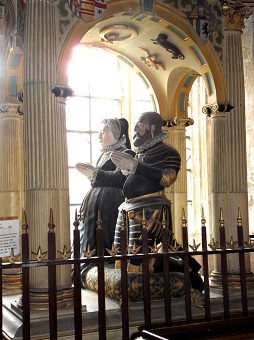 In 1943, Swindon Borough Council bought the house and park from the 6th Viscount Bolingbroke. The 18th century state rooms were restored, and quality furnishings loaned out from the National Art Collections Fund. When Lord Bolingbroke died in 1975, he bequeathed to the house everything that he owned which had originally come from it. Lydiard House is run by a board of trustees and is open to the public. The stables have been converted into a café, with equine related equipment adorning the walls and floor. The church is situated in front of the house and overlooks the lake. The oldest bells (2, 3, and 4) are from 1635, cast by Roger Purdue of Bristol. The tenor is from 1701, by Robert Cor of Aldbourne. The treble and fifth are the most recent, cast in 1964 by Taylors of Loughborough. The bells reward confident handling, but are exceptionally loud in the ringing chamber.
Lydiard Millicent The distinguishing affix denotes Millicent de Clinton, who owned the manor during the 12th century. Today the village is separated from Swindon by a narrow buffer (approx. ½ mile wide) of open fields. Still very rural, the village centres on the crossroads of ancient trade routes. The 18th century pub, The Sun Inn, provided a fine lunch and did a grand job in catering for such a large party as ours with time constraints. The primarily 14th century parish church sits in fairly small grounds, with entrance via a set of stone steps to the south, or a gate with an archway. The shaft of the churchyard cross is believed to be Saxon, providing evidence as to the existence of a pre-Norman church here. As well as this, the vestry contains a Saxon frieze found in the wall in-fill during the 1870 chancel extension. The clock on the west tower was installed as a war memorial after World War II.
In 1943, Swindon Borough Council bought the house and park from the 6th Viscount Bolingbroke. The 18th century state rooms were restored, and quality furnishings loaned out from the National Art Collections Fund. When Lord Bolingbroke died in 1975, he bequeathed to the house everything that he owned which had originally come from it. Lydiard House is run by a board of trustees and is open to the public. The stables have been converted into a café, with equine related equipment adorning the walls and floor. The church is situated in front of the house and overlooks the lake. The oldest bells (2, 3, and 4) are from 1635, cast by Roger Purdue of Bristol. The tenor is from 1701, by Robert Cor of Aldbourne. The treble and fifth are the most recent, cast in 1964 by Taylors of Loughborough. The bells reward confident handling, but are exceptionally loud in the ringing chamber.
Lydiard Millicent The distinguishing affix denotes Millicent de Clinton, who owned the manor during the 12th century. Today the village is separated from Swindon by a narrow buffer (approx. ½ mile wide) of open fields. Still very rural, the village centres on the crossroads of ancient trade routes. The 18th century pub, The Sun Inn, provided a fine lunch and did a grand job in catering for such a large party as ours with time constraints. The primarily 14th century parish church sits in fairly small grounds, with entrance via a set of stone steps to the south, or a gate with an archway. The shaft of the churchyard cross is believed to be Saxon, providing evidence as to the existence of a pre-Norman church here. As well as this, the vestry contains a Saxon frieze found in the wall in-fill during the 1870 chancel extension. The clock on the west tower was installed as a war memorial after World War II.
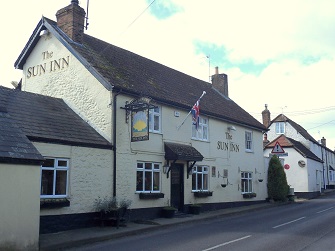
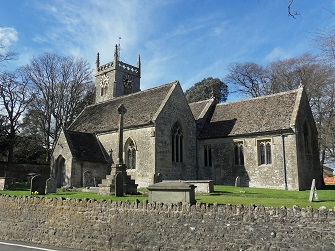 The three oldest bells (2, 4, 5) date to 1712, all cast by Abraham Rudhall of Gloucester. The second and tenor are both from 1906, cast by John Warner, London, with the treble added in 1932 by Gillett & Johnston.
Purton The name of the village derives from the Anglo-Saxon description for a pear orchard, being noted as Puritone in 796AD. The village is situated on high ground on the course of the ancient road from Cricklade to Wootton Bassett, thus affording views across the Thames floodplain. The parish also includes Purton Stoke to the north, and the hamlets of Bentham, Hayes Knoll, Restrop and Widham.
The three oldest bells (2, 4, 5) date to 1712, all cast by Abraham Rudhall of Gloucester. The second and tenor are both from 1906, cast by John Warner, London, with the treble added in 1932 by Gillett & Johnston.
Purton The name of the village derives from the Anglo-Saxon description for a pear orchard, being noted as Puritone in 796AD. The village is situated on high ground on the course of the ancient road from Cricklade to Wootton Bassett, thus affording views across the Thames floodplain. The parish also includes Purton Stoke to the north, and the hamlets of Bentham, Hayes Knoll, Restrop and Widham.
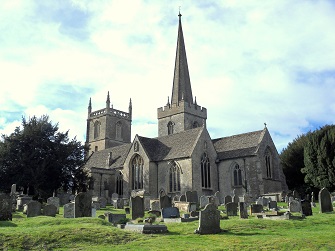 Although only four miles north of Swindon, the village is surrounded by a wealth of countryside and incorporates four nature reserves. The original dedication of the C13th / C14th parish church was to St Nicholas, and is notable for being one of only three in England to possess a central spire and another tower. One of the other two is to be found only a handful of miles away in Wanborough on the other side of Swindon. The building was subject to a restoration in 1872 carried out by William Butterfield, with a skeleton being discovered in a wall of the north transept at this time. Outside the south entrance to the church is the table tomb of former Astronomer Royal, Nevil Maskelyne (1765 – 1811). Of this still imposing set of eight, which until relatively recently used to be rung from the ground floor, the oldest bell is the fifth, cast in 1598 by Joseph Carter in Reading. The tenor is from 1738, cast by Abel Rudhall, Gloucester. The fourth is from later that century by Robert II Wells of Aldbourne. The five other bells were added by Gillett & Johnston (Croydon) and Taylors (Loughborough) during the course of the 20th century. The length of the rope draught was initially intimidating, but this was misleading as the bells actually proved to be receptive to steady handling.
Although only four miles north of Swindon, the village is surrounded by a wealth of countryside and incorporates four nature reserves. The original dedication of the C13th / C14th parish church was to St Nicholas, and is notable for being one of only three in England to possess a central spire and another tower. One of the other two is to be found only a handful of miles away in Wanborough on the other side of Swindon. The building was subject to a restoration in 1872 carried out by William Butterfield, with a skeleton being discovered in a wall of the north transept at this time. Outside the south entrance to the church is the table tomb of former Astronomer Royal, Nevil Maskelyne (1765 – 1811). Of this still imposing set of eight, which until relatively recently used to be rung from the ground floor, the oldest bell is the fifth, cast in 1598 by Joseph Carter in Reading. The tenor is from 1738, cast by Abel Rudhall, Gloucester. The fourth is from later that century by Robert II Wells of Aldbourne. The five other bells were added by Gillett & Johnston (Croydon) and Taylors (Loughborough) during the course of the 20th century. The length of the rope draught was initially intimidating, but this was misleading as the bells actually proved to be receptive to steady handling.

Royal Wootton Bassett

1725 Newsham Fire Pump

Lyneham · St Michael

Memorial window

Lydiard Tregoze

St Mary's

A tomb within St Mary

The Sun Inn

Lydiard Millicent · All Saints

Purton · St Mary
Oxfordshire
Saturday 22nd February 2014
6.00pm Wheatley
Leigh End (8) 0-2-8 in C
Paul Lucas, Susan Read, Brian Read, David Thomas, Isaac O'Shea, Mark Walker, Martin Crick and Tim Pett.
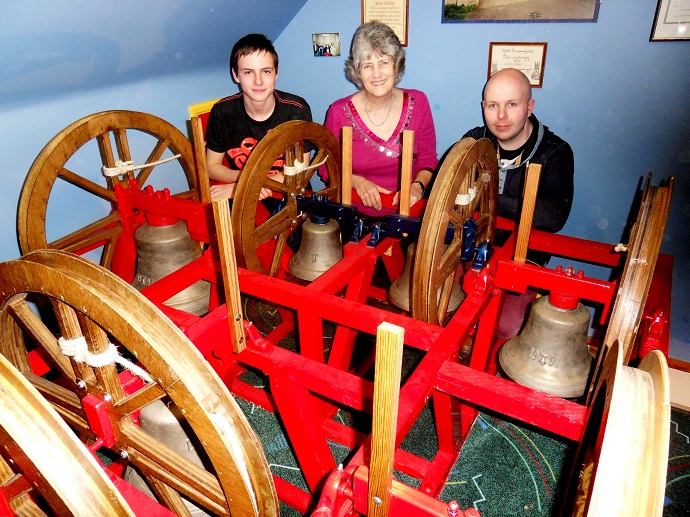
Wheatley · Leigh End
Paul Lucas writes This was to be a quarter peal attempt of Grandsire Triples. When it failed, we had a general practice instead, and then went for a curry at Cinnamons Indian Restaurant in Wheatley. We plan to attempt another quarter peal sometime soon.
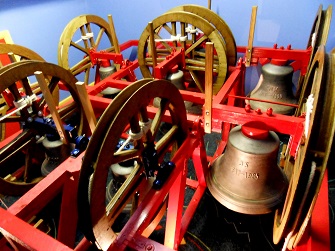
JS 1917 - 1985
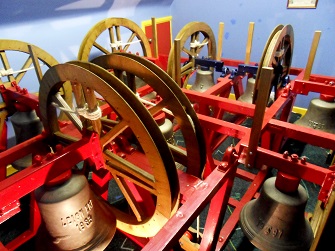
LEIGH END 1985
Oxfordshire
Saturday 22nd February 2014
Cassington
St Peter (6) 12-1-4 in F#
Freeland
St Mary V (6) 3-3-3 in D
Cassington Documented as Cersetone (farmstead where cress grows) in the Domesday Book, the settlement was later noted as Kersinton in the 13th century. Today the parish includes the hamlet of Worton to the north, and the site of the abandoned 14th century hamlet Somerford to the south. After the defeat of Charles I in the English Civil War several prominent Royalist clergymen took refuge in the village.
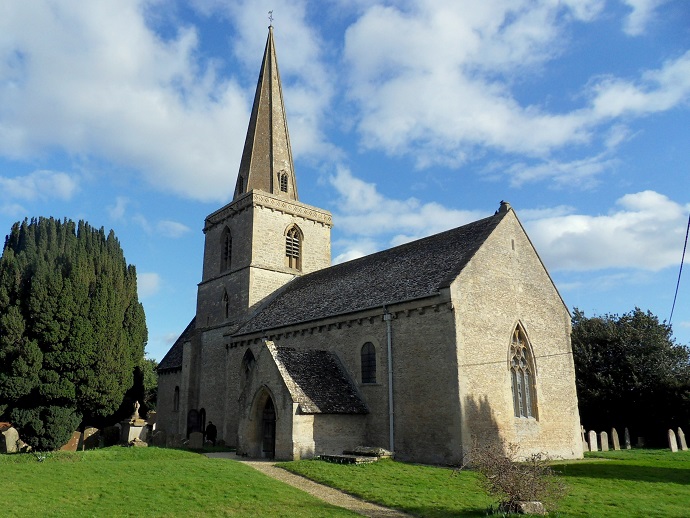 Between 1800 and 1802 the Duke of Marlborough paid for the building of a canal from the River Thames to a wharf that existed here at that time. The village is characterised by numerous rows of elegant stone cottages, much of the stone having been quarried locally. A footpath lined by lime trees leads to the parish church, which is primarily a Norman building with Gothic additions from 1318 due to Lady Montacute having been a major benefactor of St Frideswide’s Priory, Oxford. The window of the nave, east window of the chancel, upper part of the tower and broach spire all date from this period.
Between 1800 and 1802 the Duke of Marlborough paid for the building of a canal from the River Thames to a wharf that existed here at that time. The village is characterised by numerous rows of elegant stone cottages, much of the stone having been quarried locally. A footpath lined by lime trees leads to the parish church, which is primarily a Norman building with Gothic additions from 1318 due to Lady Montacute having been a major benefactor of St Frideswide’s Priory, Oxford. The window of the nave, east window of the chancel, upper part of the tower and broach spire all date from this period.
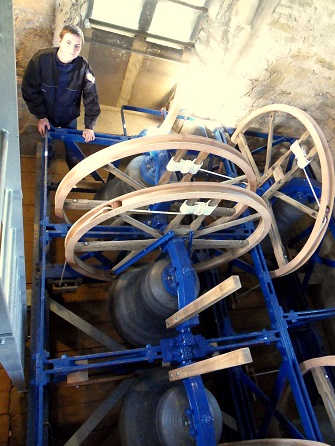
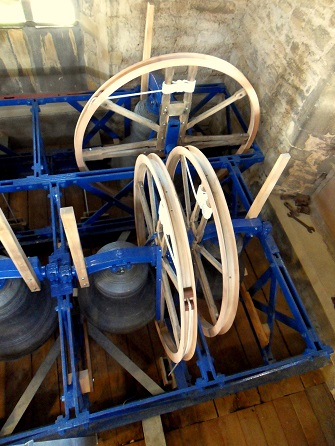 The tall spire of the church is a notable landmark that is clearly visible to motorists on the A40. The tower houses a ring of six, five of which were cast by the Keene family at their foundry in Woodstock between 1640 and 1666. The second bell is from 1953, cast by Mears & Stainbank, Whitechapel. There was a restoration during the autumn of 2013, with the bells ringing again in late October, having been silent since the Millennium.
Freeland See Saturday 16th April 2011 for details.
The tall spire of the church is a notable landmark that is clearly visible to motorists on the A40. The tower houses a ring of six, five of which were cast by the Keene family at their foundry in Woodstock between 1640 and 1666. The second bell is from 1953, cast by Mears & Stainbank, Whitechapel. There was a restoration during the autumn of 2013, with the bells ringing again in late October, having been silent since the Millennium.
Freeland See Saturday 16th April 2011 for details.

Cassington · St Peter

The bells of Cassington

St Peter's